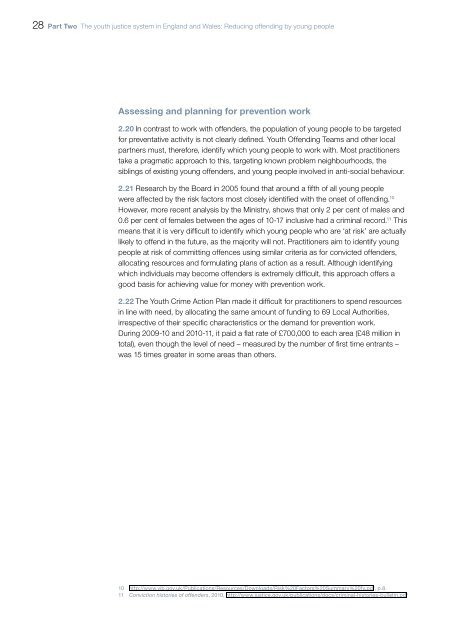full report - National Audit Office
full report - National Audit Office
full report - National Audit Office
Create successful ePaper yourself
Turn your PDF publications into a flip-book with our unique Google optimized e-Paper software.
28 Part Two The youth justice system in England and Wales: Reducing offending by young people<br />
Assessing and planning for prevention work<br />
2.20 In contrast to work with offenders, the population of young people to be targeted<br />
for preventative activity is not clearly defined. Youth Offending Teams and other local<br />
partners must, therefore, identify which young people to work with. Most practitioners<br />
take a pragmatic approach to this, targeting known problem neighbourhoods, the<br />
siblings of existing young offenders, and young people involved in anti-social behaviour.<br />
2.21 Research by the Board in 2005 found that around a fifth of all young people<br />
were affected by the risk factors most closely identified with the onset of offending. 10<br />
However, more recent analysis by the Ministry, shows that only 2 per cent of males and<br />
0.6 per cent of females between the ages of 10‐17 inclusive had a criminal record. 11 This<br />
means that it is very difficult to identify which young people who are ‘at risk’ are actually<br />
likely to offend in the future, as the majority will not. Practitioners aim to identify young<br />
people at risk of committing offences using similar criteria as for convicted offenders,<br />
allocating resources and formulating plans of action as a result. Although identifying<br />
which individuals may become offenders is extremely difficult, this approach offers a<br />
good basis for achieving value for money with prevention work.<br />
2.22 The Youth Crime Action Plan made it difficult for practitioners to spend resources<br />
in line with need, by allocating the same amount of funding to 69 Local Authorities,<br />
irrespective of their specific characteristics or the demand for prevention work.<br />
During 2009‐10 and 2010‐11, it paid a flat rate of £700,000 to each area (£48 million in<br />
total), even though the level of need – measured by the number of first time entrants –<br />
was 15 times greater in some areas than others.<br />
10 http://www.yjb.gov.uk/Publications/Resources/Downloads/Risk%20Factors%20Summary%20fv.pdf, p.8.<br />
11 Conviction histories of offenders, 2010, http://www.justice.gov.uk/publications/docs/criminal-histories-bulletin.pdf

















